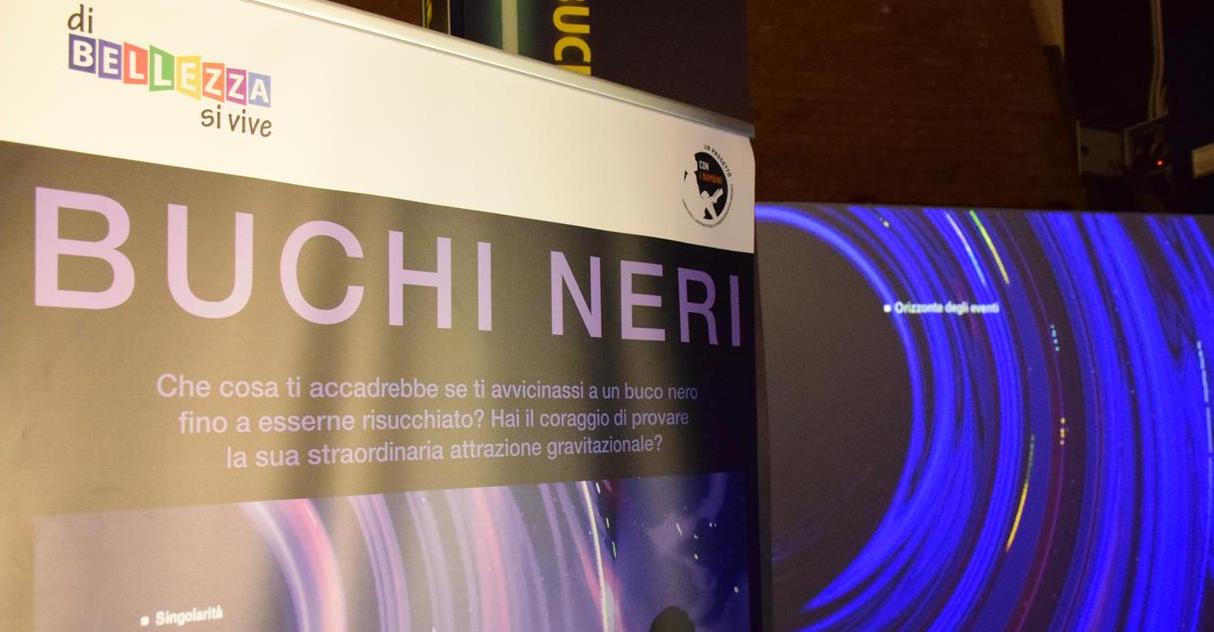 Black Holes, an immersive exhibit, was presented on May 31 at Città della Scienza in Naples. The exhibit was curated by INFN and Fondazione Horcynus Orca and Fondazione Messina, as part of the Di Bellezza Si Vive project, selected by the social enterprise Con i Bambini for the fund dedicated to counteracting child educational poverty, and it was designed by interaction designers Dotdotdot, with the scientific advice from researchers of the Virgo Collaboration and of the European Gravitational Observatory EGO. The Di Bellezza Si Vive project aims to validate, through an action-research pathway, an original educational method that demonstrates how beauty, in the fields of visual arts, music, theater, dance, and the care of places, represents a foundational experience able of extending the potential of individuals from an emotional, cognitive and behavioral point of view, counteracting educational poverty, improving living conditions and ultimately reducing social costs. In the immersive exhibit Black Holes, as the visitor gets closer and closer to the black hole, he or she can see the effects of its extraordinary gravitational attraction: as in the process called spaghettification, the image of the visitor gradually deforms and stretches toward the black hole until it is irrevocably captured by it and, after spiraling around it, is finally phagocytized, contributing to the increase in the mass of the black hole itself. In Naples, the exhibit is open to the public until July 30 as part of the “Spazio al Futuro” exhibition, organized by the Idis-Città della Scienza Foundation, in partnership with INFN and numerous other research institutes and universities.
Black Holes, an immersive exhibit, was presented on May 31 at Città della Scienza in Naples. The exhibit was curated by INFN and Fondazione Horcynus Orca and Fondazione Messina, as part of the Di Bellezza Si Vive project, selected by the social enterprise Con i Bambini for the fund dedicated to counteracting child educational poverty, and it was designed by interaction designers Dotdotdot, with the scientific advice from researchers of the Virgo Collaboration and of the European Gravitational Observatory EGO. The Di Bellezza Si Vive project aims to validate, through an action-research pathway, an original educational method that demonstrates how beauty, in the fields of visual arts, music, theater, dance, and the care of places, represents a foundational experience able of extending the potential of individuals from an emotional, cognitive and behavioral point of view, counteracting educational poverty, improving living conditions and ultimately reducing social costs. In the immersive exhibit Black Holes, as the visitor gets closer and closer to the black hole, he or she can see the effects of its extraordinary gravitational attraction: as in the process called spaghettification, the image of the visitor gradually deforms and stretches toward the black hole until it is irrevocably captured by it and, after spiraling around it, is finally phagocytized, contributing to the increase in the mass of the black hole itself. In Naples, the exhibit is open to the public until July 30 as part of the “Spazio al Futuro” exhibition, organized by the Idis-Città della Scienza Foundation, in partnership with INFN and numerous other research institutes and universities.
You might also be interested in

Quantum computing: INFN and the US SQMS laboratory renew their collaboration

Search for new physics: a possible new approach from bent crystals

Einstein Telescope: Lusatia officially enters the competition

Detecting gravitational waves from space: first steps for the LISA mission

ORIGINS. Exploring Science Communication and Journalism
